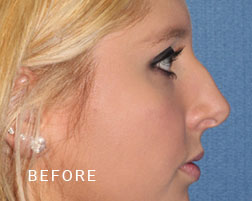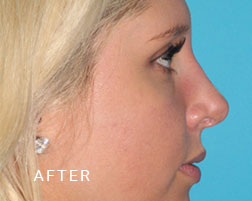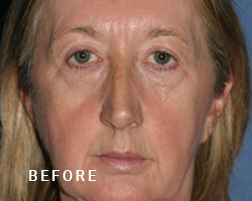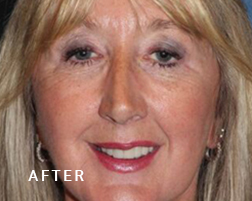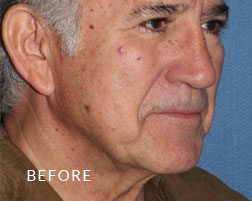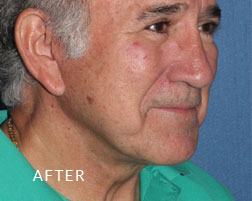Septoplasty
Offered at our convenient location in Scottsdale, Arizona
Septoplasty is a surgical rhinoplasty procedure that corrects a deviated septum. When the septum is deviated, the wall that separates the nostrils in the nose (the septum) is not properly aligned; this displacement can cause breathing difficulties, recurrent sinus infections, or blockages in one or both nostrils, making breathing and sleep difficult. Sometimes, people get septoplasty done with another nose surgery, like fixing the shape of the nose, also called rhinoplasty. If you have spent even a day trying to function with limited air flow through one or both nostrils, that’s one day too many.
Dr. Andrew Wolin is a board-certified plastic surgeon with many years of experience in performing septoplasty. He is highly skilled and dedicated to helping patients with breathing problems caused by a deviated septum. His dedication to his patients can be felt from the consultation through recovery and beyond as he maintains an open line of communication for questions or concerns. If you’re tired of struggling with breathing difficulties, it’s time to consider septoplasty. Dr. Andrew Wolin is a trusted and experienced plastic surgeon who can help. By correcting your deviated septum, he can help you breathe easier and live a better life. Call (480) 945-8440 in Scottsdale or the greater Arizona area. Patients can also schedule a consultation by messaging our scheduling coordinator online.
Contents
More About Septoplasty
Medical literature documenting the correction of nasal septal deformities dates back to ancient times. [1] Earlier methods often resulted in aesthetic issues because the nasal septum is a crucial part of the structure of the nose. If it becomes distorted, it can cause problems with breathing, the way the nose keeps its shape, and other important functions.
It goes without saying that breathing is important for our well-being – we won’t get far without it. But what restrictions does not being able to breathe without issues place on a life?
Breathing Difficulties
A deviated septum can block one or both nostrils, making it difficult to breathe through the nose; this can be especially noticeable during exercise or sleep.
Sinus Infections
A deviated septum can increase the likelihood of sinus infections by obstructing the sinus passages and making it difficult for mucus to drain properly.
Snoring Caused by Deviated Septum
A deviated septum can contribute to snoring by narrowing the airway and making it more likely that the tissues in the throat will vibrate while sleeping.
Nosebleeds
A deviated septum can make it more likely to experience nosebleeds, as the tissues in the nose can be more susceptible to drying out and cracking.
Chronic Headaches
Some people with a deviated septum may experience chronic headaches or facial pain due to sinus pressure or a chronic stuffy nose.
Some of our patients aren’t aware that their issues are caused by a deviated septum so imagine the relief when surgery performed by a skilled surgeon like Dr. Wolin is the answer. Physical and emotional stress will melt away.
Where is the Septum?
The septum is a wall of bone and cartilage in the middle of our nose that separates the two sides. It is called a deviated septum when it is not in the middle – it deviates from the “norm.”
This can happen due to injury during childbirth or from a direct blow to the nose.
How Do I Know if I Have a Deviated Septum?
A blocked nose is the most common issue reported in a typical ear, nose, and throat (ENT) clinic. [2] Approximately one-third of people are thought to have some form of nasal blockage, and around a quarter of these individuals seek surgical treatment for it. [3] Patients seeing a plastic surgeon to correct their breathing issues may have already been diagnosed, or may have aesthetic issues that make it clear there is a functional problem. Whatever your suspicions, it’s best to see a board-certified plastic surgeon for consultation so you can learn what is causing the issue and how to correct it.
What are the Benefits of Septoplasty?
The main purpose of septoplasty is to improve breathing by correcting the deviation in the septum. Improved breathing after septoplasty can indeed have a positive impact on several aspects of life:
- Sleep – A deviated septum can cause snoring, sleep apnea, and other sleep-related breathing disorders, which can lead to poor quality of sleep and daytime fatigue. Septoplasty can help improve these conditions and lead to better quality of sleep.
- Exercise – Breathing difficulties can make physical activity and exercise more challenging, especially for athletes. Improved breathing after septoplasty can make it easier to engage in physical activity, which can improve overall health and well-being.
- Speaking & Singing – Improve speech clarity and make it easier to sing without having to struggle for air.
- Mental Health – Breathing difficulties can cause stress and anxiety, especially in situations where air flow is limited, such as during air travel or in crowded public spaces.
- Physical Performance – Improved breathing can lead to increased oxygenation of the body and brain, which can result in improved energy levels and increased endurance.
- Cognitive Function – Better oxygenation of the brain can result in improved cognitive function, including memory, concentration, and overall mental clarity.
- Sense of Smell and Taste – Enhance the enjoyment of food and other sensory experiences.
Breathing difficulties can impact daily activities and limit one’s ability to fully participate in life. Improved breathing after septoplasty can lead to an overall improvement in quality of life and increased confidence in daily activities.
Candidates
There are several reasons why a patient may come to Dr. Wolin to repair their deviated septum. Some patients have had the condition present since development in the womb. Just as often, the deviated septum will have resulted from trauma to the nose, such as a broken nose; this can occur as a result of an injury, such as during a sporting accident or a fall. Dr. Wolin is adept at handling both types of deviated septum cases and will work with each patient to determine the best course of action.
The septum can become deviated over time as a result of the natural aging process, which can cause the cartilage in the nose to become more brittle and prone to deformity. Chronic infections of the nasal passages, such as sinusitis, can also cause the septum to become weakened and deviated over time.
A deviated septum can be present with or without symptoms and that not all deviated septums require surgical correction. The decision to undergo septoplasty should be based on a thorough evaluation and a discussion of the potential benefits and risks with Dr. Wolin.
Personal Consultation
Regardless of the cause of the deviated septum, Dr. Wolin takes a patient-centered approach and will carefully assess each individual’s needs and goals.. By working closely with each patient, Dr. Wolin can help ensure that the results of septoplasty are as effective and long-lasting as possible.
During the consultation, Dr. Wolin will evaluate the patient’s overall health and the extent of the deviation to determine the best approach to repairing the septum. He will perform an airflow test that detects a deviated septum with a high level of accuracy. It is easy for the patients to use and doesn’t cause any discomfort.
Once you are determined to be a good candidate for septoplasty, Dr. Wolin will explain the procedure in full, including preparation and recovery. You will be able to look at before & after pictures of patients who Dr. Wolin has treated.
Patients can expect to leave their consultation appointment feeling armed with the knowledge that will help them to determine if septoplasty is the right procedure to treat their breathing or aesthetic issues.
Preparation for Septoplasty
To prepare for surgery, Dr. Wolin will ask that you follow some precautions to ensure successful outcomes. You should stop taking blood-thinning medications such as aspirin or ibuprofen a few days before the surgery. These medicines, as well as some herbal supplements, can increase the risk of bleeding during the procedure. You should also avoid alcohol for at least 24 hours prior to the surgery and arrange for a responsible adult to drive you home after the procedure.
It is important to have a clear understanding of the procedure and what you can expect in terms of recovery as well as realistic expectations of your results.
You should prepare your home for your recovery period. This may include making arrangements for someone to help you with household chores, purchasing any necessary supplies or equipment, and preparing meals ahead of time so that you have them readily available when you get home. You should also make sure that your bed is comfortable and that you have plenty of pillows to prop up your head and relieve pressure on your nose.
If you have any concerns or questions, be sure to discuss them with Dr. Wolin so that you can have peace of mind as you prepare for your procedure.
The Septoplasty Procedure
Your septoplasty can take up to 3 hours for Dr. Wolin to complete, and patients are free to retun home for recovery after. Our team will numb your nose or put you to sleep with anesthesia, depending on the extent of your surgery.
Dr. Wolin will go inside your nose and use a tool to hold your nostrils open. If your nose needs a bigger fix, he might make a small cut on the skin between your nostrils known as an open rhinoplasty.
He will carefully lift the lining inside your nose to reveal the septum. If the septum is bent, he will remove some of it to make it straight. He might use the removed part to make other parts of your nose stronger. [4][5]
Dr. Wolin will secure the septum with sutures and dress your nose with a bandage and splint to keep it protected. If you are under general anesthesia, you will be under observation until you are cleared to leave the hospital.
Recovery
After your septoplasty procedure, you may feel some discomfort, but this can be managed with the pain medicine that you have filled from prescriptions Dr. Wolin gives you before your procedure.
Bruising and swelling around your nose and under your eyes is common and can be reduced by keeping your head elevated while resting. It’s important not to blow your nose or put pressure on the area as you recover.
Our team will give you specific instructions on how to take care of your nose and promote optimal healing. You can usually resume light activities, like work, a few days after the surgery. However, it’s best to wait 4 to 6 weeks before starting any strenuous activities like exercise.
What are the Results of Septoplasty?
By 3-6 months after the surgery, your nose should be fully healed, and you should notice an improvement in your breathing and sleeping, making you feel much better overall. You will think more clearly when you sleep more deeply and get more oxygen to your brain. If Dr. Wolin has improved your nose cosmetically you will see a boost in your confidence.
What is the Cost of Septoplasty in Scottsdale, Arizona?
When getting a septoplasty, Dr. Wolin will create a special plan just for you to fix the problem you’re concerned about; this means the cost of your septoplasty might be a little different from someone else’s. Your insurance company might pay for your surgery, so be sure to check with them after your consultation.
We look forward to helping you breathe with ease. Call (480) 945-8440 today!
References
- Fettman N, Sanford T, Sindwani R. Surgical Management of the Deviated Septum: Techniques in Septoplasty. Otolaryngologic Clinics of North America. 2009;42(2):241-252. doi:10.1016/j.otc.2009.01.005
- Konstantinidis I, Triaridis S, Triaridis A, Karagiannidis K, Kontzoglou G. Long term results following nasal septal surgery. Auris Nasus Larynx. 2005;32(4):369-374. doi:10.1016/j.anl.2005.05.011
- Bateman ND, Woolford TJ. Informed consent for septal surgery: the evidence-base. The Journal of Laryngology & Otology. 2003;117(3):186-189. doi:10.1258/002221503321192476
- Fettman, N., Sanford, T., & Sindwani, R. (2009). Surgical Management of the Deviated Septum: Techniques in Septoplasty. Otolaryngologic Clinics of North America, 42(2), 241–252. https://doi.org/10.1016/j.otc.2009.01.005
- P. Most, S., & F Rudy, S. (2017). Septoplasty: Basic and Advanced Techniques. Facial Plastic Surgery Clinics of North America, 25(2), 161–169. https://doi.org/10.1016/j.fsc.2016.12.002




